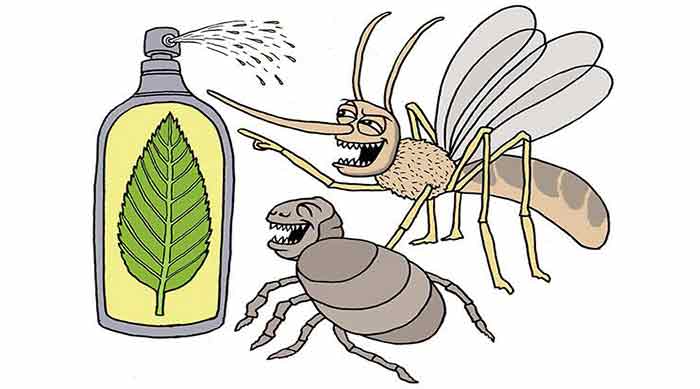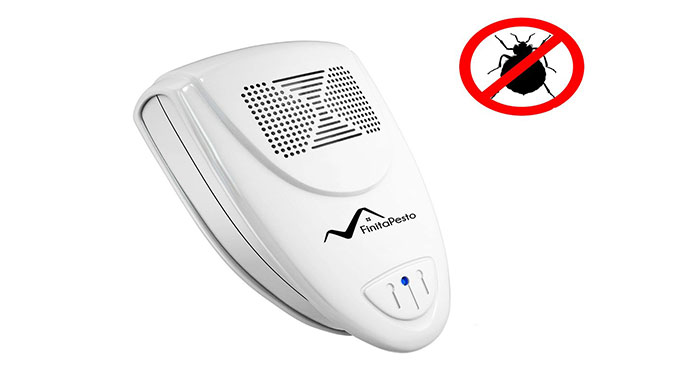Table of Contents
What are Bed Bug Repellents & How do they work?
What they are?
Repellents are just but one of the indications of pesticides. They discourage and prevent infestations or harmful effects of bed bugs among other critters such as mosquitoes, ticks, lice, etc. Did you know that ‘pesticides’ is a term that is used to refer to not only something that is indicated to kill insects but is a broader term than you might know?
- Spatial repellents such as some heating mechanisms used in candles, coils, torches and lanterns.
- Clip-on repellents from which the repellent chemical is dispersed near your body to prevent approach.
- Creams and ointments applied topically on the skin
- Electronic devices such as ultrasonic repellents
- Sprays
How they work
Bed bug repellents contain specific chemicals that keep bed bugs away or from entering your space. There are very limited options to the chemical you can use to keep bed bugs away. According to the Journal of Economic Entomology’s 2013 Ed., DEET (N,N-diethyl-meta-toluamide) has been listed as the best chemical product for repelling bed bugs. Other chemicals that are in the wait list but have shown significant efficacy are 3-methyl-5-hexyl-2-cyclohexenone, propyl dihydrojasmonate and Y-methyl tridecalactone. The above chemicals need to be used in the dosages indicated in the instructions and directions for purposes of your skin’s safety. DEET, for instance, has shown strong efficacy when used in concentrations of 25%. According to the Journal of Medical Entomology, in a publication by Davis EE et al, (1985), the repellent DEET targets the central nervous system and the peripheral nervous system. There are however five propositions concerning the mechanism of action of the repellents. They:- Inhibit response of the critter to chemotactic stimuli by the host
- Stimulation of a competing response that masks stimuli to host attractants.
- Acts as a highly concentrated attractant hence shifting focus of the insect to it rather than to the host.
- It literally ‘jams’ the sensory circuit by increasing the noise/signal ratio
- Stimulation of natural avoidance receptors hence resulting in disinterest in the host.
Natural & Homemade bed bug repellents
Homemade
Homemade bed bug repellents are also options you can opt for. If you can access diatomite, then you have a good repellent, diatomaceous earth. This material can be placed on the ground and used to repel and at the same time kill bed bugs. It works by dehydrating the exoskeleton of the bed bug and hence preventing molting and therefore growth. You can also make a vinegar solution then spray it directly on the bugs. This will help repel the bed bugs for some time while you think of doing something long-term about them. In order to make this happen, you can purchase some vinegar then fill a bottle with a 1:1 ratio mixture of vinegar and water. Sprinkle in areas with bed bugs including their hiding spots to prevent their coming out.Natural bed bug repellent-Scents & Oils
Scents
There are repellents that are scented. Most of these are essential oils such as eucalyptus or lavender oil. Note that most of these oils mentioned in this section have some menthol in them and hence this similarity raises the possibility of its acting to repel bed bugs. One good example is the lemon eucalyptus which has a derivative of menthol, p-menthane-3,8-diol (PMD) as the active compound. Some of the scented oils that you can acquire and use include:- Eucalyptus oil
- Tea tree oil
- Lavendar oil
- Neem oil
- Lemon grass
- Lemon eucalyptus
Oils
Much of the oils that are used as repellents of bed bugs are scented as mentioned in the previous section.
- Catnip oil with the active principle, Nepetalactone
- Fish oil in combination with the Birch tree back
- Citronella oil
- Cinnamon oil
- Clove oil
- Thyme oil
Bed bug repellent creams, Sprays & Electronic
Creams
Creams that show efficacy in repelling bed bugs include those that are herbal such as those made form neem oil or other oils mentioned earlier. Lotions are more popular as they do not adhere to the skin as much and causing discomfort when you apply right before bed time. They therefore get positive reviews. The creams and lotions confer protection from bed bugs for a few hours and they die out before the night is over hence may still allow bed bugs into your space. This will therefor force you to reapply the oil or lotion for added protection. Those that have some petroleum jelly have also been shown to be effective in repelling bed bugs.Sprays
Sprays can be indicated as a formulation in administration of the repellent chemical. However, this formulation has been shown to be ineffective as when the liquid has dried out, bed bugs win. Therefore, sprays do exist as bed bug repellents though the entomologist do not find it effective.Rubbing alcohol
This method is mostly used in the elimination of bed bugs though has been discouraged due to the high possibility of potential fires when care not taken. It is possible to kill the critters with alcohol upon contact but this is not considered an option in repelling bed bugs. Its aqueous nature allows it to dry up hence not offering any benefit to the host.Electronic repellent
This is not a new method. It has been hyped and used in a bid to repel not only bed bugs but other insects such as mosquitoes and cockroaches. The efficacy of this method has been questioned severally and studies relating to the same have been published. Comically, a study showed that instead of the ultrasonic repellent doing its job as expected, it led to an increase in the biting rates of mosquitoes. According to the Journal of Economic Entomology, this method does not work well as it has been advertised by its manufacturers. It was further found that there is not difference between the changes in behavior when bed bugs were exposed to the electronic repellent and when not. Therefore, they do not work.Ultrasonic bed bug repeller
Ultrasonic bed bug repellent is an electronic repellent that is meant to keep bed bugs away. Just one of the methods that are currently filling the market in the name of helping people do away with bed bugs or prevent their adverse biting and discomfort.
Repellent mattress cover
There are two types of such covers depending on whether they are just encasements or fortified encasements with a chemical impregnation to them. Both of these are commercially available. What is the difference between these two options? They are commonly a source of confusion. In the case of encasements, these are covers that completely cover the mattress including the box spring. This provides a barrier to the entry or escape of bed bugs and will prevent any impending bites from a bed bug. This method is particularly good when you have sprayed your dwelling or use some other elimination or treatment method and you have bought a new mattress. In the first two weeks when you are monitoring the effectiveness of the treatment method, you can encase your mattress to prevent a secondary infestation of a new mattress and box spring. This is a highly recommended method by experts and professional pest services. Mattress covers that have been impregnated are not complete encasements meaning that they do not cover the mattress completely. Neither do they cover the box spring as does the mattress encasement. They simply fit the mattress at the top and the sides. The advantage to this type of cover is that they are impregnated with an insect repellent such as permethrin. Bed bugs are therefore not able to reach you or the host as when it comes into contact with the cover, they are killed.Best Natural bed bug repellent for skin & Body
What to consider when selecting
It is important to select what works and what will be worth you expenditure. It will be disappointing spending lots on a repellent that does not work. Therefore consider doing the following:- Do some research on the reviews of different repellent methods to make you make an informed choice.
- Seek some advice from a professional pest control on the best repellent to purchase. They most definitely know with which you could do better.
- Expense and economics is a considerable factor that may influence your purchasing power. You can get something natural and less expensive that will work.
- If you have any allergic reaction to particular chemicals such as DEET or pyrethrin, then it would be wise to avoid using repellents that contain them.
- Make sure that what you are selecting from the shelves is approved for use and has not been associated with toxicity in its trials.
Which is the best?
The best natural bed bug repellent is that with a mixture of lavender and peppermint oil. Zen Garden™ contains the two ingredients. It is considered the best natural bed bug repellent as it does not contain any synthetic ingredient. This can thus be used by those who would simply want to avoid chemicals or are allergic to them. Apart from the lavender and peppermint, it contains Roman chamomile and organic eucalyptus. It can be applied on the skin, linen, pillows, blankets and other bedding.How to use
This is an easy process.- Spray the natural home bed bug repellent onto your bare body.
- Rub the formulation to spread it over your skin.
- Spray the repellent onto bedding such as blankets and bed sheets including your pajamas. Don’t forget your pillow. You can also spray into the pillow case.
- Spray the corners of your bed and the mattress to prevent passage of bed bugs from the corners of the bed onto the corners of the mattresses.
- Bed Bug Facts and Frequently asked Questions FAQs
- How to Kill and get rid of bed bugs for good
- How to prevent bed bugs
- Bed Bug Bombs-Do Foggers work? Effectiveness & Reviews
- Bed Bug Repellents -Natural Homemade, Creams, Electronic & Reviews
- How do Bed Bugs Spread? Are they Contagious? How Fast/Easily from Person, Room or House?
- Best Bed Bug Sprays-DIY Homemade, Natural, Brand Reviews
- Flea Bites vs Bed Bug Bites + Differences & Pictures
- How to Prevent Bed Bugs-Bites while Sleeping at Home, School, Hotel & Travelling
- How to get rid of Bed Bugs on Clothes-Can they Live, Bite through or Travel on Laundry
- Fumigation for Bed Bugs-Cost & Preparation
- How to get Bed Bugs out of Carpet with Cleaner & Powder
- How Long do Bed Bugs Live Without Food, Host, Air, in Cold & After Spraying
- Bed Bug Rash on Skin, Pictures, Treatment, Allergy & Symptoms
- Where do Bed Bugs Hide and how to Find them
- Mosquito Bites vs Bed Bug Bites-What’ are the differences
- Identifying Bed Bug Eggs- How they look like, Images & destruction
- How do you know if you have Bed Bugs-Symptoms & Signs
- Bed Bug vs Spider Bites- Differences with Pictures
- Bed Bug Sniffing Dogs-How they smell, Sense, Roscoe, Breeds & Cost
- What are Bed Bugs? Names in other Languages
- Where do Bed Bugs come from? Causes, how you get them & Start
- How to Kill/Get Rid of Bed Bugs Fast Yourself Naturally for Good
- Bed Bugs in Hair Symptoms, Pictures & Get rid
- Types of Bed Bugs
- Bed Bug Poop/Droppings-How it looks like, Pictures +Identification
- Bed Bug Shells, Cast Skin & Exoskeleton
- Can you See Bed Bugs with the Naked eye? Pictures, Size, Color & Anatomy
- Dust Mite vs Bed Bug Bites
- Bed Bug life cycle-Eggs, Baby(Nymph) to Adult Stages & Pictures
- How to Detect Bed Bugs-Detectors, Light & Verifi Reviews
- How to know if Bed Bugs are gone after Treatment & what to do
- Will Bleach Kill Bed Bugs-How does it work?
- Best Bed Bugs Traps- DIY Homemade, Co2, Yeast + Reviews
- How to Deal with Bed Bugs in your Car
- Bed Bugs in Couch-Covers, Signs & How to Get rid
- How to Kill Bed Bugs with Steam: Best Steamers & Guide + Tips
- Does Alcohol Kill Bed Bugs? Rubbing, Isopropyl & Percentage
- How Long do Bed Bug Bites Last, Take to Appear, Go Away & Heal
- Natural Predator of Bed Bugs-What Insects/Bugs eat Bed Bugs?
- Can Bed Bugs Live in TVs & Other Electronics? How to get them out
- Do Bed Bug Bites Itch or Hurt?
- Bed Bug Interceptor-How it works, DIY & Reviews
- What do Bed Bug Bites look like? Pictures & Identification Steps
- What Attracts Bed Bugs & things they Hate /Dislike Most
- Can Bed Bugs make you Sick? How are they Dangerous?
- Can Bed Bugs Fly-Do they have Wings-How Far can they Travel
- Diatomaceous Earth for Bed Bugs-How to Use & Best Reviews
- DIY Bed Bug Heat Treatment: Success Rate,Temperature Chart, Preparation & Reviews
- Does Vinegar Kill Bed Bugs? Can it be Used for Bites?
- How to Get Rid of Bed Bugs on Mattress- Best Covers, Protectors & Encasement Reviews
- Can Bed Bugs live on or Bite Dogs & Cats (Pets)?
- Bugs that look like Bed Bugs-Beetles & Others that Resemble or Mistaken